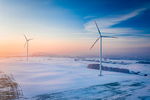Striking the right balance between wind energy and biodiversity
Three EPFL labs were involved in developing the model in partnership with the University of Bucharest in Romania. Researchers from the Wind Engineering and Renewable Energy Laboratory (WIRE), the Ecological Systems Laboratory (ECOS) and the Laboratory of Geographic Information Systems (LASIG) pooled their data and models with those of experts from the University of Bucharest's Centre of Landscape–Territory–Information Systems (CeLTIS) as part of a ground-breaking initiative in wind energy.
Their aim is to provide the local authorities with a model they can use to simulate in a given landscape the wind energy potential in the long term, taking into account the evolution of the landscape and its biodiversity: the model allows to integrate for instance the role of agricultural land use. This is important for striking the right balance between arable land and pastureland, which can help to generate strong winds, and natural woodland, where the trees tend to reduce the performance of wind farms.
This study was part of the WindLand project funded by the Swiss National Science Foundation, through a scientific partnership involving SCCER-FURIES, InnoSuisse and Romania. The case study simulated the impact of land use policy on wind energy potential and biodiversity in the Southern Carpathians, even though no such project is in the pipeline for the moment.
Don't shoot for maximum production
For authorities interested in building a wind farm, the model provides data on how much wind energy can be produced and how heterogeneous the landscape has to be in order to preserve local biodiversity. According to the study, if the surrounding area is predominantly woodland, the wind farm will produce only 60% of its maximum capacity and biodiversity will be moderate. On the other hand, if the area is totally cleared for pasture and intensive farming, the wind farm will be at full production but biodiversity will be considerably reduced owing to the mundane landscape.
When the right balance is struck between agricultural land and forest, the wind farm can maintain 70–80% of its production capacity, and biodiversity remains high because of the heterogeneous landscape and diverse habitats. Another advantage of this multidisciplinary coupled model is that it quantifies the wind farm's energy production throughout its useful life.
The topography and landscape of the Carpathian Mountains are similar to those of Switzerland's Jura region, with mountains – ranging from 930 to 1,400 meters – dotted with forests, fields and pastures, as well as isolated tress. The model could therefore be applied in Switzerland as well.
Finding a compromise
"Our findings show that it's possible to reach a compromise between biodiversity and wind-energy production and that trying to achieve maximum energy output straightaway is an error," explains Jiannong Fang, a researcher at the WIRE Lab and lead author of the study, which was published in the June issue of Science of the Total Environment, in partnership with Swiss Federal Institute for Forest, Snow and Landscape Research (WSL).
A physicist by training, Fang learned to speak the language of his ecology and geography colleagues in the ECOS and LASIG labs in order to integrate economic, agronomic, social, environmental and topographic data into his model. "Thanks to the models from those labs, I was able to improve my wind energy predictions and extend them over the long term,” says Fang. “I was also able to look at how the landscape and surrounding forest could be developed and how this would impact wind energy potential."
Since the fall of communism, large patches of wooded pastureland, which covered half of the Carpathian region, have been left abandoned. These areas used to be very biodiverse, and the strong winds would have made them an ideal spot for a wind farm. But today the forest is claiming back its territory. The simulator developed by EPFL aims to determine how the landscape can be used effectively for wind production while also preserving the region’s current biodiversity.
Jiannong Fang is looking to further hone his model: "Climate change may have a slight impact on our findings. Adding various climate scenarios relating, for instance, to changes in humidity and vegetation would make our model's predictions even more reliable and could be the topic of a future work."
References:
Jiannong Fang, Alexander Peringer, Mihai-Sorin Stupariu, Ileana P?tru-Stupariu, Alexandre Buttler, Francois Golay, Fernando Porté-Agel, “Shifts in wind energy potential following land-use driven vegetation dynamics in complex terrain,” Science of the Total Environment, June 2018.
(Available online. Will be published in the print issue of October 2018)
- Source:
- EPFL
- Author:
- Sandrine Perroud
- Link:
- actu.epfl.ch/...
- Keywords:
- EPFL, turbine, wind energy, biodiversity, researchers, study, performance, Romania























